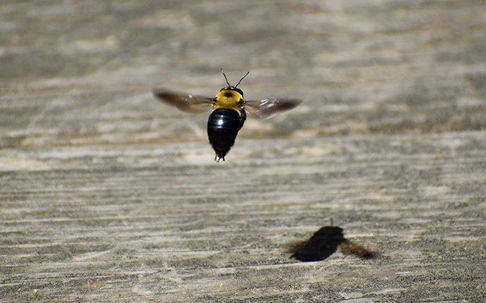Carpenter bees are tenacious critters with strong jaws and the ability to vibrate. As strange as this sounds, this is exactly how carpenter bees tunnel their way through wood. If you aren’t familiar with carpenter bees and the problems they cause, we are here today with everything you need to know.
What Are Carpenter Bees?
Carpenter bees are a species of stinging insects known for the way they tunnel their homes into structures of wood. Just like their cousin the bumblebee, carpenter bees are fat and have a fluffy thorax (midsection). The thing that sets them apart is their hairless, sleek black abdomens (hind section). Carpenter bees also have a tiny black spot in the middle of the top of their thorax.
Carpenter bees are solitary insects that live on their own rather than in large nests. For this reason, each individual bee must fend for itself and build its own home. To construct a home, carpenter bees will first search for a section of wood that has been softened by water damage, rot, or decay. Once they found an ideal location, they will use their strong jaws and vibrate to a deep tunnel. Although the entrances to these tunnels are only a half of an inch wide, they can travel over ten feet into wood.
Pros And Cons Of Carpenter Bees
Carpenter bees are not all bad; in fact, they are one of the most important creatures on the planet. Just like honey bees, carpenter bees help pollinate flowers and other budding plants. This behavior is crucial for healthy plant growth. Without pollination, the health of our planet would decline rapidly.
As beneficial as carpenter bees can be, they are also frustrating pests. If you have wooden structures on your property, they could be at risk of a carpenter bee infestation. As you can guess, bees tunneling into your home is not good for its value. Hungry woodpeckers will even make holes bigger trying to peck out carpenter bees.
Carpenter bees will also sting. Unlike honey bees, carpenter bee’s stingers aren’t barbed. This means they are capable of stinging multiple times in a row. If you are allergic to stinging insects, be extra careful around these pests. To find out if you are allergic, talk to your doctor. If you experience an allergic reaction including intense swelling or difficulty breathing, seek medical attention immediately.
Prevention Tips For Carpenter Bees
There are several things that will help keep carpenter bees off your Bay Area property. If you are up for the task of preventing carpenter bees on your own, here are a few prevention tips you should try:
- Paint or varnish unfinished wood around your property.
- Fill in gaps and cracks in the exterior of your home and outbuildings using a caulking gun.
- Place screening of metal flashing around the rough ends of deck boards.
- Pick up fruit around your property that has dropped from trees.
- Clean up thoroughly after outdoor gatherings.
- Consider removing flowers and other budding plants from your property.
Despite your efforts to keep pests away, you may still find yourself experiencing a carpenter bee or other stinging insect problem. For extra help with carpenter bee prevention, or to have an active infestation eliminated from your property, reach out to the experts at Bay Pest. We have the equipment and training needed to quickly and effectively handle any pest problem. Reach out to our team today to schedule a service visit for your Bay Area property.

